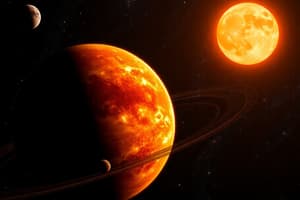Podcast
Questions and Answers
Which planet is known to have the largest number of moons?
Which planet is known to have the largest number of moons?
- Neptune
- Saturn
- Earth
- Jupiter (correct)
Which scientist is known for advocating the heliocentric model?
Which scientist is known for advocating the heliocentric model?
- Newton
- Kepler
- Galileo (correct)
- Ptolemy
What major discovery is attributed to Isaac Newton concerning planetary motion?
What major discovery is attributed to Isaac Newton concerning planetary motion?
- Gravity attracts objects toward each other. (correct)
- Inertia is irrelevant to planetary motion.
- Planets move in circular orbits.
- Gravity is proportional to the square of the distance.
What is the primary reason that planets maintain their orbits around the Sun, according to Newton?
What is the primary reason that planets maintain their orbits around the Sun, according to Newton?
Which planet is characterized by its rings and enormous size?
Which planet is characterized by its rings and enormous size?
What element primarily contributes to Mars' reddish appearance?
What element primarily contributes to Mars' reddish appearance?
What describes the structure of Saturn?
What describes the structure of Saturn?
Which of the following statements about Copernicus is true?
Which of the following statements about Copernicus is true?
What significant event in cosmic history occurred 13.8 billion years ago?
What significant event in cosmic history occurred 13.8 billion years ago?
What model did Ptolemy support regarding the structure of the universe?
What model did Ptolemy support regarding the structure of the universe?
Flashcards are hidden until you start studying
Study Notes
Earth and Its Characteristics
- Only known planet supporting life; over 70% of its surface is water.
Saturn
- Second-largest planet in the solar system; recognized for its prominent ring system.
Neptune
- Known as the coldest planet; features the Great Dark Spot, a storm-like feature.
Mercury
- Smallest and innermost planet in the solar system; closest to the Sun.
Mars
- Appears red due to iron oxide (rust) in its soil; surface has some similarities to Earth.
Jupiter
- Largest planet in the solar system; has 79 known moons and a notable Great Red Spot.
Venus
- Nearly the same size as Earth (95%); brightest object in the sky after the Sun and Moon; extremely hot with a toxic atmosphere.
Historical Figures in Astronomy
Isaac Newton
- Formulated the law of universal gravitation; gravity's strength depends on the mass of objects and their distance from each other.
- Explained planetary orbits as a balance between gravitational pull from the Sun and inertia.
Galileo Galilei
- Advocated for the heliocentric model, suggesting the Sun at the center of our solar system.
- Improved telescopic technology, leading to discoveries including four of Jupiter's moons; faced persecution for his revolutionary ideas.
Johannes Kepler
- Introduced the concept that planetary orbits are elliptical in shape.
- Supported Newton's ideas that gravity and inertia govern planetary motion.
Claudius Ptolemy
- Promoted the geocentric model where Earth was believed to be the center of the universe; Moon and Sun were thought to revolve around Earth.
Nicolaus Copernicus
- Proposed a heliocentric model where the Sun is at the center of the solar system; ideas remained unchallenged for 200 years.
- His theories were published posthumously, catalyzing a shift in astronomical thought.
The Big Bang Theory
- Occurred 13.8 billion years ago; universe started as a dense point before expanding and cooling to form matter.
Planetary Distances and Surface Features
Saturn
- Distance from the Sun: 886 million miles; lacks a solid surface, consists mainly of swirling gases.
Uranus
- A gas giant with a cold atmosphere; distance from the Sun: 1.8 billion miles; does not have a solid surface.
Neptune
- Diameter of 24,622 miles, approximately 3.9 times larger than Earth; consists of gases with no solid surface; distance from the Sun: 2.8 billion miles.
Mercury
- Smallest planet, closest to the Sun.
Venus
- Comparable in size to Earth; known for extreme surface temperatures and volcanic activity; atmosphere consists of sulfuric acid clouds.
Mars
- Roughly half the size of Earth; has a thin atmosphere similar to that of Earth but with less density; surface gravity is weaker than Earth's.
Studying That Suits You
Use AI to generate personalized quizzes and flashcards to suit your learning preferences.




